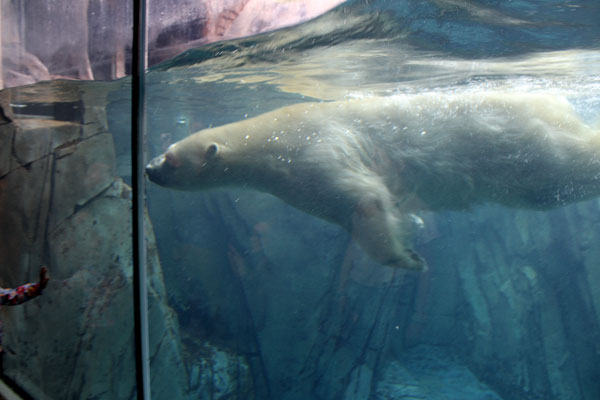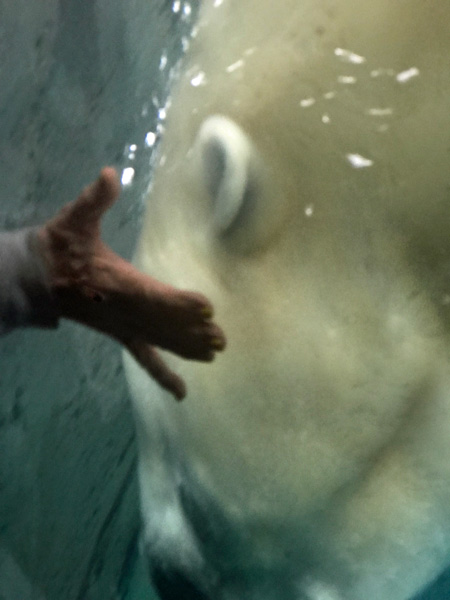Page 2 - Black, Brown and Polar Bears
at The St. Louis Zoo
|
The most fun
that Karen Duquette had at the zoo was with the bears. Both the polar
bear and the Brown Grizzly bear kept coming to the viewing window and
making everyone laugh, "oooh and ah" and have a great
time. |

|

|
THE BLACK BEAR |
The American black bear is
a medium-sized bear here in North America. It is the continent's smallest
and most widely distributed bear species. American black bears eat foods
that are both plants and animal in origin, depending on season and location.
They typically live in largely forested areas, but will leave forests
in search of food, and are sometimes attracted to human communities
due to the immediate availability of food. Despite the name, some subspecies
can be brown or even blond in coloration.
The American black bear is widespread in its areas of residence due
to a large population estimated to be twice that of all other bear species
combined. Along with the brown bear, it is one of only two modern bear
species not considered to be globally threatened with extinction. |
There was only one black bear
to be seen on this date and it was not easy to get a photo of it through
the glass. He was lounging lazily in a tree. |
 |
 |
The Brown Grizzly Bear |
Below: Differences between brown bears
and grizzly bears! They are basically the same species, but live in
different geographic location, which influences diet, size and behavior.
Those that live in coastal areas of Alaska are called brown bears, while
typically inland bears that have limited or no access to marine-derived
food resources are often smaller and called grizzlies. Both have the
same distinctive body shape described below.
 Distinctive shoulder hump.
Distinctive shoulder hump.
 Rump is lower than shoulder hump.
Rump is lower than shoulder hump.
 Face profile appears dished in between the eyes and tip of the snout.
Face profile appears dished in between the eyes and tip of the snout.
 Ears are short and round.
Ears are short and round.
 Front claws are slightly curved and 2-4 inches longs, depending on how
much digging the bear does.
Front claws are slightly curved and 2-4 inches longs, depending on how
much digging the bear does.
 Toes are close together, and form a fairly straight line. A line drawn
under the big toe across the top of the pad runs through or below the
bottom half of the little toe on grizzly/brown bear tracks. Claw marks
are often visible in the tracks.
Toes are close together, and form a fairly straight line. A line drawn
under the big toe across the top of the pad runs through or below the
bottom half of the little toe on grizzly/brown bear tracks. Claw marks
are often visible in the tracks.
 Brown bears are larger than black bears, standing 3-5 feet at the shoulder
when on all fours.
Brown bears are larger than black bears, standing 3-5 feet at the shoulder
when on all fours.
|
Below: The brown bear was very exciting.
Each time he came up to the viewing window, all the children (and Karen
Duquette) just loved it. It was so much fun watching him bounce up and
down at the window. |

|
 |
 |
 |

|
 |
Below: The bear would sometimes
take s short break from the water and walk around its perimeter, then
return to the viewing area. |
 |
 |
 |
 |
Below: Lee
Duquette's hand on the glass and Karen Duquette's reflection in the
glass. |
 |
 |
| |
THE POLAR BEAR |
The polar bear is a hyper carnivorous bear whose native range lies
largely within the Arctic Circle, encompassing the Arctic Ocean, its
surrounding seas and surrounding land masses. It is the largest bear
species still in existence, as well as the largest existing land carnivore.
A boar (adult male) weighs around 770–1,540 pounds, while a sow (adult
female) is about half that size. Although it is the sister species of
the brown bear, it has evolved to occupy a narrower ecological niche,
with many body characteristics adapted for cold temperatures, for moving
across snow, ice and open water, and for hunting seals, which make up
most of its diet. Although most polar bears are born on land, they spend
most of their time on the sea ice. Their scientific name means "maritime
bear" and derives from this fact. Polar bears hunt their preferred
food of seals from the edge of sea ice, often living off fat reserves
when no sea ice is present. Because of their dependence on the sea ice,
polar bears are classified as marine mammals. |
Below: The Polar
Bear was also a lot of fun to watch. He would swim in front of the window
then come up for air. As shown below, when he came up for air, the photo
gives the illusion that his head is small and not attached to his body
that is still under water. |
 |
 |
 |
 |
Below: Karen
Duquette's hand against the window as if she was petting the polar bear. |
 |
 |
 |
 |
 |
 |
 |
 |
|
Below: From a side viewing area, Karen Duquette got
clear pictures of the polar bear as he came up for air.
|
 |
 |
 |
 |

































